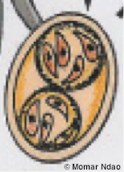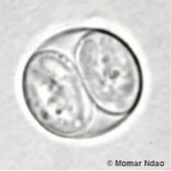Toxoplasma gondii
Contributor: Momar Ndao
Biology: Toxoplasma gondii belongs to the Apicomplexa phylum. T. gondii is a parasite of birds and mammals. Felines are the only definitive host and the only animals that pass infective oocysts in their faeces. Warm-blooded animals, including humans, are intermediate hosts that harbour tissue cysts (containing bradyzoites) in their bodies.


Figure 1. Two mature sporulatedToxoplasma gondii oocysts (10-12 µm in diameter). Right: image shows the two sporocysts within the mature oocyst. Left: Image shows the four sporozoites within each sporocyst.
Life Cycle: The life cycle consists of a sexual cycle in its feline definitive host and an asexual cycle in its intermediate host. Infection is most often initiated through the ingestion of oocysts containing sporozoites or cysts containing bradyzoites in contaminated food or water. Following ingestion, the sporozoites or bradyzoites invade the intestinal epithelium and differentiate to tachyzoites, which disseminate and replicate within the new host. In feline infections, on ingestion of T. gondii cysts, the enclosed bradyzoites are released in the feline and quickly transform into tachyzoites. Both sexual and asexual reproduction occur in the gut of the feline. The sexual cycle results in the production of immature oocysts which are in the stool. The oocysts complete their maturation in the outside environment and become infectious 1 to 5 days after shedding. Intermediate hosts, including human, can be infected after the ingestion of raw or undercooked meat containing tissue cysts or after consumption of food or water contaminated with oocysts.

Figure 2. Toxoplasma gondii life cycle (Source: CDC).
Transmission: Toxoplasma infects up to a third of the world’s population. Toxoplasma is transmitted by consuming poorly-cooked infected meats, ingestion of water, food, inhalation of aerosols containing oocysts and contact with sand or soil contaminated by cat faeces. The infection can be life threatening during pregnancy and immunocompromised individuals. Since the 1990s waterborne T. gondii has been implicated in numerous outbreaks. In 1995, a major outbreak of toxoplasmosis due to contaminated municipal drinking waters affected 110 individuals in the Greater Victoria Area, British Columbia. Congenital toxoplasmosis occurs and ranges from one to 10 per 10,000 live births. Transfusion or organ transplantation from an infected individual can also transmit the parasite.
Prevalence: Worldwide distribution. Worldwide estimated seroprevalence for T. gondii are: i) 30 to 40% in domestic cats, ii) 23% in market pigs, and iii) 42% in breeder pigs. It has been documented that T. gondii infection occurs in up to 20% of the population of United States. In the US, it has been estimated that 4,000 infants are born with transplacentally- acquired T. gondii infection each year.
Susceptible Populations: Immunocompromised persons (AIDS, transplant recipients or cancer patients on immunosuppressive therapy) and pregnant women.
Symptoms: In acute infection, mild symptoms can arise, including fever, fatigue, rash, headache, myalgia, lymphadenopathy, lymphadenomegaly, weight loss, weakness and pneumonia. Congenital infection can result in abortion or stillbirth, and live births may result in mental retardation, malformation, retinochoroiditis, strabismus, nystagmus, microphthalmia, and cataracts.
Treatment: Daraprim (trisulfapyrimidines and pyrimethamine) is the drug of choice. Pregnant women should avoid pyrimethamine. An alternative drug is spiramycin which is used in Canada, Europe and Mexico but not FDA approved in USA. The drug of choice for cerebral toxoplasmosis in patients with AIDS is atovaquone.
Control Measures: Hands should be washed after contact with potentially contaminated soil or meat that may contain tissue cysts. Meat should be thoroughly cooked. Avoid contact with cat faeces by wearing gloves when cleaning out a cat litter box. Cats should not be feed raw or undercooked meat. Toxoplasma oocysts can survive in moist soil or water for up to 18 months. They can survive in uncovered faeces for 46 days, and for 334 days when covered.
Toxoplasma oocysts are resistant to most disinfectants. Chlorine treatment will not inactivate the oocysts. However, 10% formalin decreases viability significantly. In addition, tincture of iodine (2%) treatment for 3 hours and temperature of 55-60°C for 1-2 minutes will inactivate T. gondii oocysts. People should avoid ingesting untreated water from lakes, ponds, streams even during recreational activities. Use of 1 μm filter will eliminate T. gondii oocysts (10-12 μm) and also Cryptosporidium spp. (3-5 um) from contaminated water.